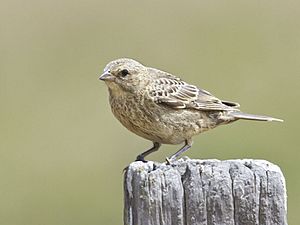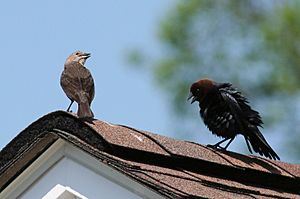Brown-headed cowbird facts for kids
Quick facts for kids Brown-headed cowbird |
|
|---|---|
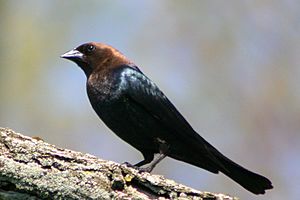 |
|
| Adult male | |
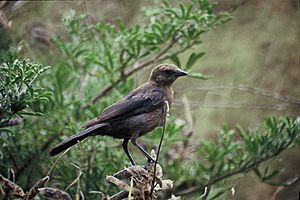 |
|
| Adult female | |
| Conservation status | |
| Scientific classification | |
| Genus: |
Molothrus
|
| Species: |
ater
|
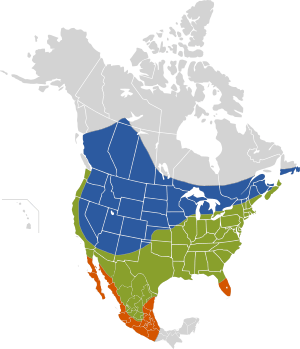 |
|
| Breeding range Year-round range Wintering range | |
The brown-headed cowbird (Molothrus ater) is a small bird found in North America. These birds are known for a special behavior called brood parasitism. This means they lay their eggs in the nests of other birds.
Cowbirds live in the southern parts of their range all year. Birds from the northern areas fly south for winter. They travel to the southern United States and Mexico. They usually return to their summer homes around March or April.
Contents
What's in a Name?
The brown-headed cowbird got its scientific name, Molothrus ater, in 1783. The word Molothrus comes from Ancient Greek. It means "struggle" or "battle" and "to sire." The word ater is Latin for "dull black."
The English name "cowbird" was first used in 1839. It refers to how these birds are often seen near cattle. They follow grazing animals to find insects.
There are three types, or subspecies, of brown-headed cowbirds:
- M. a. artemisiae: Found in western Canada and the western USA.
- M. a. obscurus: Lives along the coasts of Alaska, Canada, the USA, and northwest Mexico.
- M. a. ater: Found in southeast Canada, the eastern and central USA, and northeast Mexico.
How to Spot a Cowbird
Brown-headed cowbirds have a unique look. They have a head and beak similar to a finch. They are also smaller than many other birds in their family.
Adult male cowbirds are shiny black with a brown head. Females are a bit smaller and dull gray. They have a pale throat and light streaks on their belly.
These birds are about 6 to 9 inches (16 to 22 cm) long. Their wingspan is about 14 inches (36 cm). Males weigh around 1.7 ounces (49 grams). Females are slightly lighter, at about 1.4 ounces (38.8 grams).
Where They Live
Brown-headed cowbirds prefer open areas or places with some trees. They often fly in large groups. Sometimes, they mix with other birds like red-winged blackbirds or European starlings.
These birds look for food on the ground. They often follow animals like horses and cattle. When these larger animals graze, they stir up insects. The cowbirds then catch and eat these insects. Their main diet is seeds and insects.
Before European settlers arrived, cowbirds followed American bison herds across the prairies. As forests were cleared and new grazing animals were brought in, their population grew. Today, you can often see brown-headed cowbirds at bird feeders in towns and cities.
Cowbird Behavior
Brood Parasites
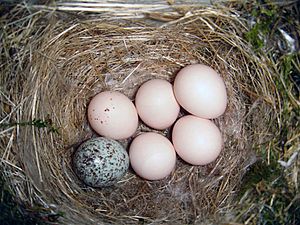
Brown-headed cowbirds are known as "brood parasites." This means they don't build their own nests or raise their own young. Instead, the female cowbird lays her eggs in the nests of other small passerines (perching birds). They especially like birds that build cup-shaped nests.
Cowbird eggs have been found in the nests of at least 220 different bird species. These include tiny hummingbirds and even larger birds of prey. The host parents then feed the young cowbird. This often means their own young don't get enough food.
A female brown-headed cowbird can lay up to 36 eggs in one season. More than 140 different bird species have been known to raise young cowbirds.
Some host birds, like the house finch, feed their babies only plants. This diet is not good for young cowbirds. Because of this, almost no cowbirds raised by house finches survive.
How Young Cowbirds Learn
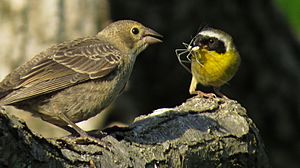
Since cowbirds don't raise their own young, baby cowbirds don't learn from their parents. They don't see or hear their own species growing up. But even so, cowbirds learn how to sing, act, and breed like other cowbirds.
A study in 2017 showed that cowbird brains are wired to recognize the sounds of other cowbirds. This helps young cowbirds find and join groups of their own kind. These special sounds are like a "password" that all cowbirds use. If a young cowbird doesn't hear these sounds by a certain age, it might think its host species is its own family.
Male Social Life
Male cowbirds have interesting social behaviors. They often have singing contests with other males. They also form pairs and stay with one female.
Studies have shown that the social environment is very important for cowbirds. For example, if young males only interact with females, they might not learn how to sing or pair bond properly. Adult males who live with younger males tend to have more success in breeding. This is because the younger males create a more complex social setting.
Males who live in a stable group of birds tend to have predictable breeding success. The males who sing to females most often have the best success. However, males who live in groups where birds are constantly changing have less predictable results.
Cowbirds and People
Because brown-headed cowbirds have spread widely and are brood parasites, some people see them as a problem. Sometimes, programs are set up to control cowbird numbers. The goal is to protect other bird species that are harmed by cowbird parasitism.
However, one study on Bell's vireo nests showed something interesting. Removing cowbirds from an area might actually lead to more cowbird babies surviving. This is because with fewer cowbirds, fewer nests are abandoned by host parents. This means more cowbird eggs hatch and grow up.
See also
 In Spanish: Tordo cabecicafé para niños
In Spanish: Tordo cabecicafé para niños



